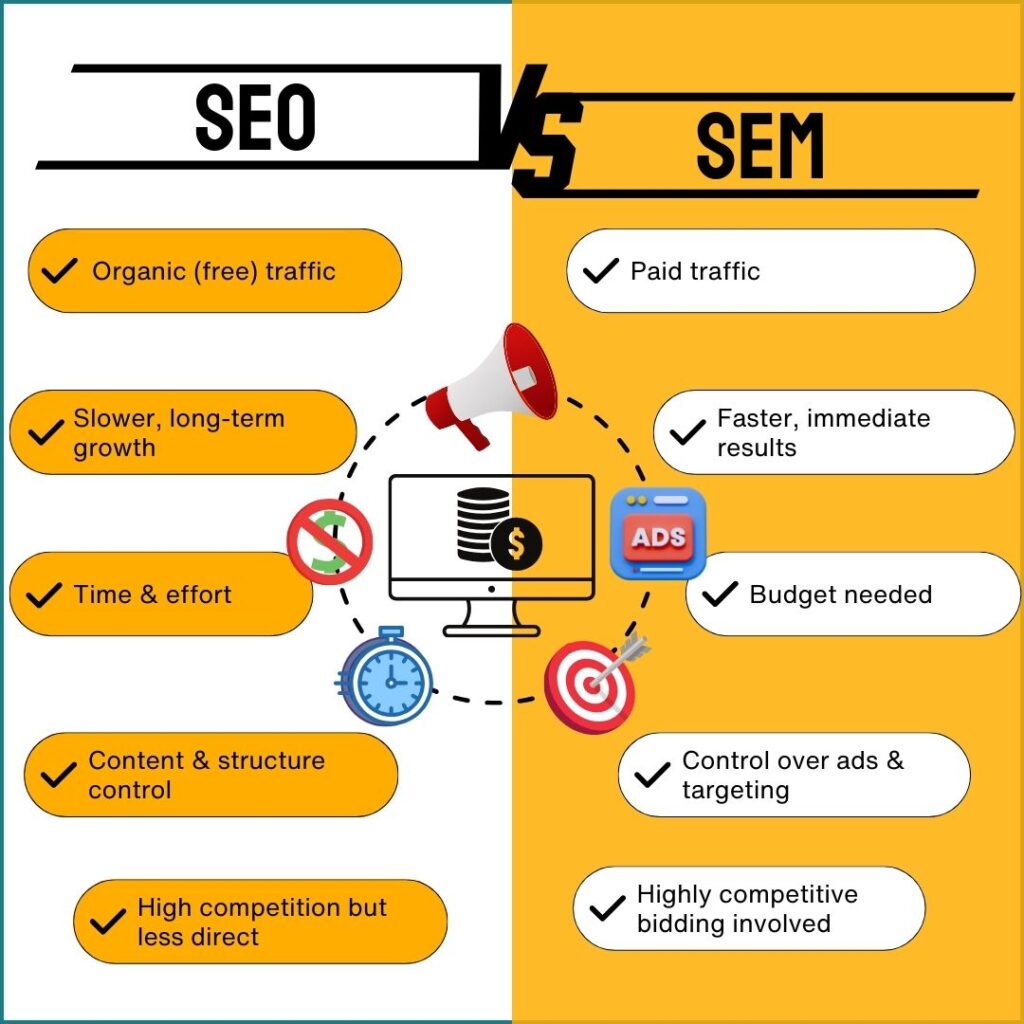Hey there, digital marketing newbies and curious cats! Ready to dive into the alphabet soup of online marketing? Today, we’re stirring up a tasty brew of SEO Vs SEM. Don’t worry if these acronyms sound like a foreign language right now – by the end of this post, you’ll be tossing them around like a pro!
Did you know that 68% of all online experiences begin with a search engine? That’s right, folks – whether you’re looking for cat memes or trying to find the best pizza place in town, search engines are the go-to starting point.
This is why understanding SEO (Search Engine Optimization) and SEM (Search Engine Marketing) is crucial for any business looking to make waves in the digital ocean.
In this fun-filled journey, we’ll explore the ins and outs of SEO and SEM, uncover their key differences, and show you how to use both to skyrocket your online presence. So, grab your favorite beverage, get comfy, and let’s embark on this exciting adventure through the land of digital marketing!
What is SEO?
The Organic Traffic Magnet
Picture SEO as the charming host of a fantastic party. Its job is to make your website so irresistible that search engines can’t help but invite it to the top of the results page. SEO is all about optimizing your website to attract organic (non-paid) traffic from search engines like Google, Bing, and Yahoo.
Key Components of SEO:
- On-page optimization: Making your website content relevant and valuable
- Off-page optimization: Building credibility through backlinks and social signals
- Technical SEO: Ensuring your website is easy for search engines to crawl and understand
- Content creation: Producing high-quality, relevant content that answers users’ questions
What is SEM?
Paid Traffic on Steroids
If SEO is the charming host, SEM is the VIP pass that gets you instant access to the hottest spots in town. SEM involves paid advertising on search engines, primarily through pay-per-click (PPC) campaigns. It’s like putting your website on a digital billboard right at the top of search results.
Essential Elements of SEM:
- Keyword research: Finding the right terms to target in your ads
- Ad creation: Crafting compelling ad copy that entices clicks
- Bid management: Optimizing your budget to get the most bang for your buck
- Landing page optimization: Ensuring visitors take action once they click your ad
Key Differences Between SEO vs SEM

Time Frame: The Tortoise and the Hare
SEO is like planting a garden. It takes time, patience, and consistent effort to see results, but once your garden blooms, it can provide a steady stream of organic traffic for years to come. On the other hand, SEM is like ordering fast food – you get instant results, but you need to keep paying to maintain them.
Cost: Free vs. Pay-to-Play
While SEO doesn’t require a direct monetary investment, it does demand time and effort. It’s like working out – you don’t pay for a gym membership, but you still need to put in the sweat equity. SEM, however, is a pay-to-play game. You’ll need to shell out some cash to get your ads in front of eyeballs.
Results: Long-Term vs. Immediate
SEO is the slow and steady approach that builds lasting results. It’s like building a reputation – it takes time, but once established, it’s hard to shake. SEM delivers immediate visibility, but it’s more like a sugar rush. The moment you stop paying, your visibility disappears.
Benefits of Using Both Strategies in Your Digital Marketing Plan
The Dynamic Duo of Online Visibility
Combining SEO and SEM is like having your cake and eating it too. You get the best of both worlds – immediate visibility from SEM while building long-term organic growth through SEO.
Complementary Strengths:
- SEO provides credibility and trust
- SEM offers quick wins and data for optimization
- Together, they maximize your online real estate in search results
Integrating SEO vs. SEM for Maximum Impact
The Perfect Recipe for Digital Success
Imagine SEO and SEM as the ingredients in your secret sauce for digital marketing success. Here’s how to blend them:
- Use SEM to test keywords before investing in long-term SEO efforts
- Leverage SEO insights to improve your SEM campaigns
- Use SEM to cover gaps while your SEO efforts gain traction
- Retarget organic visitors through SEM to increase conversions
SEO vs. SEM Case Study: Real-World Success
Meet Sarah, owner of “Pawsome Pet Supplies.” She used SEM to quickly gain visibility for her new online store while simultaneously working on her SEO. Within six months, her organic traffic grew by 150%, and her SEM campaigns drove a 200% increase in sales. By year-end, Sarah had a thriving online presence with a healthy mix of organic and paid traffic.
Choosing Between SEO vs. SEM for Your Business Needs
When to Use SEO:
- You’re in it for the long haul and want sustainable growth
- You have valuable content to share and establish authority
- You’re operating on a limited budget but have time to invest
When to Use SEM:
- You need immediate visibility (e.g., for a product launch)
- You’re in a highly competitive market and need to stand out
- You want to target specific demographics or locations precisely
Finding the Right Balance:
The key is to find the sweet spot that works for your business. Start with a mix of both, then adjust based on your results and goals. Remember, it’s not about choosing one over the other – it’s about using them together to create a powerhouse digital marketing strategy.
Conclusion:
And there you have it, folks! We’ve embarked on an exciting journey of SEO and SEM, uncovering their secrets and learning how to harness their powers for digital marketing greatness. Remember, SEO and SEM aren’t rivals – they’re more like peanut butter and jelly, better together than apart.
Whether you’re just starting out or looking to level up your digital game, understanding the difference between SEO and SEM is your ticket to online success. So, go forth and conquer the digital realm with your newfound knowledge!
Ready to put your SEO Vs SEM knowledge into action?
Whether you’re a seasoned marketer or a curious newbie, understanding the difference between SEO and SEM is crucial. Don’t forget to analyze your current digital marketing strategy and identify areas where you can implement SEO tactics or leverage SEM for a quick boost. For a deeper dive into SEO best practices, check out this Google’s SEO Starter Guide
If you’re new to SEO entirely, Moz’s Beginner’s Guide to SEO offers a fantastic introduction
Remember, the digital world is your oyster!
By integrating SEO and SEM strategies, you can cultivate a thriving online presence and achieve long-term success. So, go forth, experiment, track your results, and make some digital marketing pearls!
Read this Next: How to Optimize Your Blog Posts


![How to Optimize Blog Posts for SEO: A Beginner’s Checklist [2024 Guide]](https://yakirdigital.com/wp-content/uploads/2024/07/Yakir-Digital-Feature-Image-1-768x402.png)

